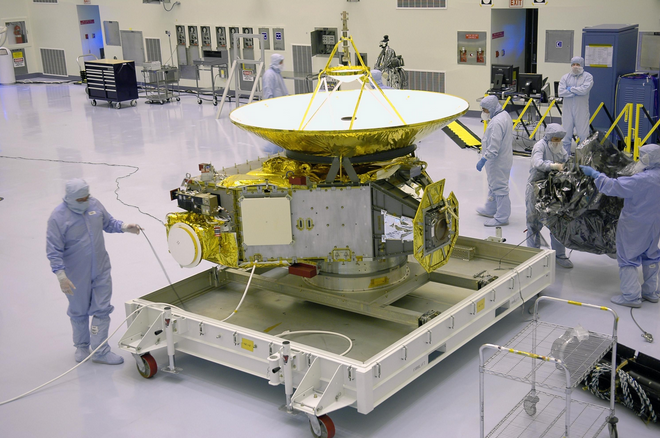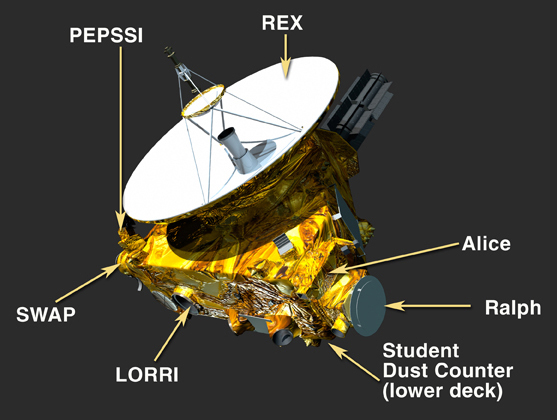The camera that photographs Pluto
For many decades since its discovery in 1930, scientists could not consider Pluto. Without high-quality images, they could not answer the basic questions about its surface and atmosphere. But on Tuesday, New Horizons flew past Pluto and took a lot of pictures that will fill books and museums for a long time and bring researchers closer to understanding the origin of life in our universe.
An important role in the success of the expedition is played by the tools that the New Horizons space station is equipped with. What difficulties did the developers of the Ralph camera overcome so that it could please us with excellent pictures ten years after launch into space? Ralph Camera

The Ralph camera is similar to a conventional SLR camera with an aperture diameter of 75 mm and aperture f / 8.7. But to make it much more difficult, because the trip should have taken at least nine and a half years. The system must cope with the influence of the space environment - radiation, temperature fluctuations - during this period.
Lowering the temperature causes the materials to compress, while different materials are compressed at different speeds. The developers decided to make Ralph from one material - aluminum, so that the volume of parts changed at the same time, preserving the focal length. Even the mirrors are made of diamond-treated aluminum.
Only the lens is made of glass.

Ralph Scheme
Another difficulty was the lack of light. Ralph was to take pictures using only sunlight reaching Pluto. Flash on New Horizons is not provided. During the flight, New Horizons photographed the side of Pluto, directed from the Sun - the light was reflected from Charon. “It's like taking a photo using light from a quarter of the moon on Earth,” comments a senior engineer responsible for optics in the mission.
The camera was developed specifically for such lighting conditions, it can not be reconfigured. Cannot change aperture size. The device was supposed to get the minimum number of photons and turn them into an image. Therefore, Ralph is extremely susceptible to bright light. Light reflected from the Moon or Earth could destroy Ralph, causing researchers to keep the aperture closed for almost two years.
20 months after launch, in 2007, New Horizons photographed Jupiter and its moon.

NASA needed as much fuel as possible on board the New Horizons, so all instruments had to be as light as possible. The developers told the agency what mass the instrument will have, but NASA asked to make it even easier to extend the journey.
As a result, Ralph weighed 10.4 kilograms - below the requirements voiced by the agency. In this case, the instrument consumes 7 watts of electrical energy, like a normal night light.
There was not much time for development: the team hoped to design, build and test Ralph in 36 months, but completed work in 22 months. After that, nine and a half years the camera flew to Pluto. And she reached the goal, being close to him for several hours .

Traveling New Horizons, NASA, Kennedy Space Center, 2006. Clickable

Layout on New Horizons
An important role in the success of the expedition is played by the tools that the New Horizons space station is equipped with. What difficulties did the developers of the Ralph camera overcome so that it could please us with excellent pictures ten years after launch into space? Ralph Camera

Temperature differences
The Ralph camera is similar to a conventional SLR camera with an aperture diameter of 75 mm and aperture f / 8.7. But to make it much more difficult, because the trip should have taken at least nine and a half years. The system must cope with the influence of the space environment - radiation, temperature fluctuations - during this period.
Lowering the temperature causes the materials to compress, while different materials are compressed at different speeds. The developers decided to make Ralph from one material - aluminum, so that the volume of parts changed at the same time, preserving the focal length. Even the mirrors are made of diamond-treated aluminum.
Only the lens is made of glass.

Ralph Scheme
Need more light
Another difficulty was the lack of light. Ralph was to take pictures using only sunlight reaching Pluto. Flash on New Horizons is not provided. During the flight, New Horizons photographed the side of Pluto, directed from the Sun - the light was reflected from Charon. “It's like taking a photo using light from a quarter of the moon on Earth,” comments a senior engineer responsible for optics in the mission.
The camera was developed specifically for such lighting conditions, it can not be reconfigured. Cannot change aperture size. The device was supposed to get the minimum number of photons and turn them into an image. Therefore, Ralph is extremely susceptible to bright light. Light reflected from the Moon or Earth could destroy Ralph, causing researchers to keep the aperture closed for almost two years.
20 months after launch, in 2007, New Horizons photographed Jupiter and its moon.

Need less mass
NASA needed as much fuel as possible on board the New Horizons, so all instruments had to be as light as possible. The developers told the agency what mass the instrument will have, but NASA asked to make it even easier to extend the journey.
As a result, Ralph weighed 10.4 kilograms - below the requirements voiced by the agency. In this case, the instrument consumes 7 watts of electrical energy, like a normal night light.
There was not much time for development: the team hoped to design, build and test Ralph in 36 months, but completed work in 22 months. After that, nine and a half years the camera flew to Pluto. And she reached the goal, being close to him for several hours .

Traveling New Horizons, NASA, Kennedy Space Center, 2006. Clickable

Layout on New Horizons
